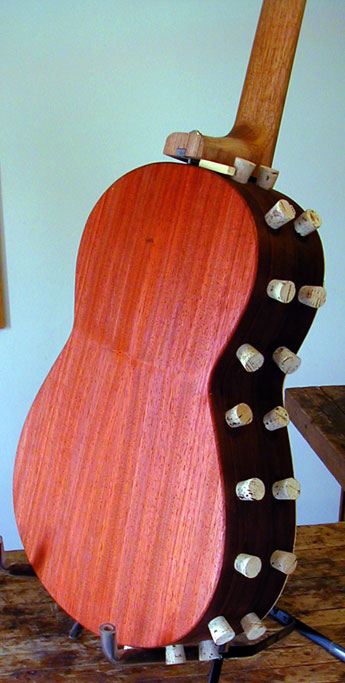|
|
 |
|
 |
| |
It's usually the simplest questions
that take the most work to answer. If you don't beleive me, talk
to a three-year-old sometime when they get on to “why?”.
Anyway, one of my customers was interested in the current fad for
“ports” in the side of the guitar, and asked if I could
make him one. I really dislike getting on the road without a map:
I wanted to know where this might take me, so I built an experimental
guitar that I could measure to see what would happen.
It never fails! It
took a week to make the guitar, and a month to get the measurements.
I also took it out the the Healdsburg Festival so that I could get
people to try it and tell me what they thought happened,
both as players and as listeners. This helped me to pick out the
“best” place to put a port. After all that work, the results
were clear and are simply stated.
Most of the sound of the guitar is produced as a result
of the “bass reflex couple” between the “main top” and
“main air” resonances, with some help from the back if that's “tuned”right.
Most of the other resonances don't radiate sound very effectively, or else they
are out of phase with the main ones. When they are poor radiators they just waste
energy in various kinds of loss mechanisms, and when they are out of phase they
cancel some of the sound that would otherwise be produced by the bass reflex
couple. These other resonances thus tend to show up as dips in the output spectrum
There are
a number of air resonances in particular that are not “heard” by
the soundhole, and these thus end up being “losers” in general. Putting
a hole in the guitar in some other location can allow these resonances to be
heard and will tend to increase the output of the guitar in the narrow frequency
range where the resonance is active, compared to what it would be without the
“port.” A “dip” in the normal guitar's spectrum often
gets “filled in” a bit when you open a port.
Opening another
hole in the guitar also makes the main “bass reflex” action
weaker because it relieves some of the pressure change in the
“main air” resonance that helps to drive it. This has the
effect of reducing the output of the guitar slightly over a broad
frequency range.
Overall
there is a very small increase (about 1-2%) in the output power
of the instrument averaged over the entire spectrum. This is composed
of an approximate doubling of power in a small frequency band
with an overall drop in level over the rest of the spectrum. A
port in the “right” place can give a particular guitar
a “better” or “worse” sound depending
on the spectral ranges that get enhanced and reduced.
The port also tends to give off sound in a directional
way. Depending on it's location, this can direct more tone at the player, forming
a useful “monitor” for people who play in noisy circumstances
or who tend to play primarily for their own enjoyment. A careful choice
of port location is needed to get the maximum benefit. Some port
locations radiate a different spectral balance than that given
off in front of the guitar, and would thus tend to give the player
a false picture of the tone being produced.
Finally, opening a
port tends to raise the frequencies of most of the air resonances. If, as often
happens, these are coupling with wood resonances to produce “interesting”features
of the tone, then these features may be lost. This can be compensated for, to
some degree, by changing the size and location of the “main” soundhole.
|
|

